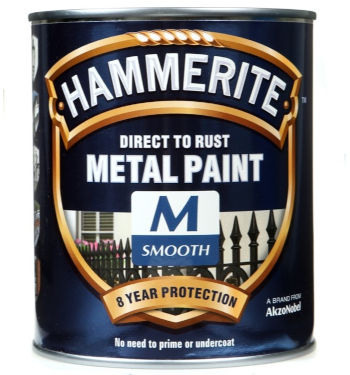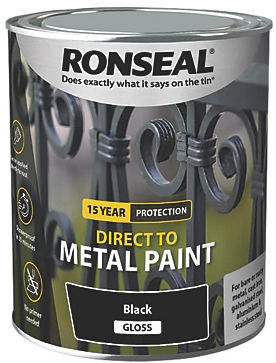Rusted or tarnished metal work can be restored and protected by the application of specialist metal paint. Painting metal isn't a difficult job but care should be taken in the surface preparation and paint selection. Get the job done right with our handy guide and you'll get a finish that will last for years to come.
What's the best paint to use on metal?
It goes without saying that you'll need a specialist paint formulated for use on metal surfaces. Don't be tempted to use an ordinary paint as it won't adhere to the surface and will peel and flake off over time.
The best quality metal paints provide a highly durable and corrosion resistant decorative coating to both ferrous and non-ferrous metals.
Advances in water-based paint technology means that many metal paints available today don't require a primer. Water based paints are also quick drying, easy to apply and ultra durable in many cases promising protection for 10+ years. Not only that metal paints can be mixed to a wide variety of colours so you're not limited to the traditional grey or black finishes.
Many metal paints can also be applied directly onto rusty surfaces making the process even quicker.
We recommend
We wouldn't hesitate to recommend either of the following fantastic metal paints. Both water based and self-priming yet offering superb durability.

Hammerite Direct To Rust Metal Paint
Hammerite Direct To Rust Metal Paint has a smooth gloss finish which will retain its sheen for years. It is a durable, corrosion resistant decorative coating for ferrous and non-ferrous metals.
- Available in a further 25 colours
- Can be applied directly onto rusty metal by roller or brush.
- Primer or undercoat are not necessary.

Ronseal 15 Year Protection Direct to Metal Paint
Ronseal 15 Year Protection Direct to Metal Paint gives you a tough and durable finish to your metal. It takes minimal prep, doesn’t need a primer and can be applied directly to rust.
- 15-year protection
- Quick re-coat time
- Showerproof in 30 minutes
- Apply directly to rust
- Low odour
- No primer needed
If you're painting bare zinc, aluminium or galvanised steel you might want to apply a primer to the surface before applying a top coat. Applying a primer in these cases will give maximum adhesion of the top coat although many water based paint systems won't require a primer.
Preparing metal for painting
Preparation is key to a good finish with most decorating jobs and painting metal is no different. Before you start make sure to lay down dust sheets or newspaper to protect the ground and surrounding areas.
- Remove flaking paint, rust and accumulated dirt from the surface using a wire brush.
- Fine grit sandpaper can be used if you don't have a wire brush to hand.
- Consider using a drill with a wire brush attachment as this will greatly speed up the process
- Ensure adequate ventilation and wear gloves and a dust mask so as to avoid inhaling rust or paint particles.
- Use an old cloth or rag soaked in white spirit to remove dirt, dust and grease.
- Don't be tempted to skip this step as although the surface may appear clean any leftover grime will prevent the new paint from adhering properly.
- Using 240 grit sandpaper rub down the entire surface until it's smooth. This step provides a key for the new paint to stick to. Lastly, wipe down the surface with a damp cloth to remove any dust before moving on to the next step!
How to paint metal
If you're using a self-priming 'direct to metal' paint then no priming is required.
Be sure to read the instructions on the side of the tin and follow any manufacturers recommendations.
If you're painting inside ensure adequate ventilation by opening windows and doors. If you're outside check the weather forecast and ensure you choose a warm, dry day.
If you're using a brush or roller the following the below steps.
- Stir the paint in the tin for a few minutes ensuring the contents are mixed thoroughly.
- Using a brush or roller apply a thin coat of paint over the surface of the metal.
- Use the rim of the tin to remove excess paint from the brush. This will help to avoid runs or drips and prevent paint accumulating in detail areas giving in a nice even finish.
- Use long smooth strokes along the same direction for the best results.
- Allow the first coat to dry as indicated on the tin. Once the first coast is dry apply subsequent coats, usually 2-3 but check the side of the tin to see how many coats are required.
- Once the paint is thoroughly dried consider applying a coat of sealant to give added protection and durability.
If you're using a spray can follow these steps:
- Shake can vigorously, in a vertical motion, until the agitator ball is heard and then for a further 3 minutes.
- Apply light even coats, from a distance of approximately 15cm (6 inches) and keep the aerosol moving. Do NOT concentrate spray in one spot.
- Wait for the first coat to dry and apply 3-4 coats for maximum protection allowing each coat to adequately dry.
- Between coats invert can and spray for 2 seconds to avoid blockages.
Tools & Equipment
- Paint stirrer
- Cloths/rags
- Wire brush
- Fine grit sandpaper
- Metal paint
- Paintbrush/roller/sprayer
- Metal primer
- Dust sheet
- Gloves and mask
- White spirit
Clean up
Once the painting is complete all that's left is to clean up and admire your work. Job done!

